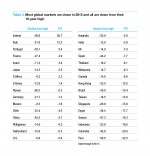Investing
Fixed Income
U.S. longer-term interest rates have been falling since 1980. Ten-year Treasury note yields peaked at 15.3 percent in September 1981 and fell to a low of 1.5 percent in July 2012. The average yield on the 10-year Treasury for August 2015 was 2.2 percent.
Yields on mortgage-backed securities have generally followed the yields on Treasurys. Since 1997, yields on mortgage-backed securities have averaged about 1.25 percentage points above yields on Treasurys, based on data from Bank of America Merrill Lynch (Chart 5). For August 2015, mortgage yields were only about 1 percentage point above Treasurys.
Two key trends are likely to influence mortgage-backed security yields going forward. First, with the Fed moving closer to raising short-term interest rates, longer-term Treasury yields and mortgage-backed security yields are likely to face some upward pressure. Possibly offsetting that may be some improvement in mortgage loan quality as U.S. borrowers benefit from continued improvement in the labor market and accelerating wage gains. Improved loan quality implies a somewhat lower risk associated with home loans and therefore should lead to acceptance of slightly lower yields by investors.
The bottom line is that with yields so low, total returns on fixed-income investments are unlikely to match returns posted during the great bond bull market from 1980 to 2012. Investors reviewing their asset allocations should carefully consider the benefits and trade-offs of fixed-income holdings as well as assumptions of future returns on these investments.
Commodities
Nearly all commodity markets have experienced substantial price declines in recent years, and lumber is no exception. In addition to factors such as a strong dollar and weak global growth that have weighed on most commodity prices, lumber is under added pressure from weakness in U.S. single-family home construction.
Futures markets show that lumber prices have been reasonably predictable based on single-family home construction starts over the past 25 years (Chart 6). Lumber futures historically have been more volatile than housing starts, so it’s not unusual to see prices showing larger gains and declines than the construction data suggest, even as they generally trend the same way. Recently, however, lumber prices have fallen while single-family home starts have slowly risen.
This divergence has two possible explanations. Either futures prices have overshot to the downside, meaning that investors are overly pessimistic about the outlook for home construction, which suggests that lumber prices may rebound, or investors are more prescient about the future. If so, that may mean additional declines in home starts.
Many factors will likely affect the single-family home market in the quarters and years ahead. From a business-cycle perspective, continued moderate growth in the economy should support better jobs and income gains. Economists have long thought that higher interest rates on mortgages reduce home purchases. However, recent research shows that down payments have a larger impact on demand than interest costs. Subtler and less predictable are the demographic trends. As more boomers turn 65, more may sell their primary residence and decide to spend retirement in their vacation home. It may take longer for more younger Americans, especially millennials, to determine whether home ownership still represents a good investment. Meanwhile, investors and builders will be left to wonder whether single-family houses or condominiums are a better bet.
U.S. Equities
In contrast to the weak housing outlook suggested by the lumber futures market, stock prices for homebuilding companies appear to reflect a somewhat more optimistic view, in line with recent trends in construction starts. Over the past 20 years, stock prices as measured by the Standard & Poor’s S&P 1500 Homebuilders index have generally tracked the performance of single-family housing starts, though with periods of excess volatility or optimism.
Interestingly, the period with the most excessive optimism came during the 2000-2005 housing boom. While this may have been predictable, it is surprising that the bubble in share prices for homebuilder stocks during the housing boom was bigger than the one that inflated NASDAQ tech issues in the late 1990s. From 2000 through the peak in 2005, the S&P 1500 Homebuilder index rose more than 570 percent. By comparison, the NASDAQ Composite Index climbed about 550 percent between 1995 and its March 2000 peak. Following the collapse in homebuilder stocks, the S&P index performed about in line with the broader market. But it has generally outperformed the broader market since 2011 (Chart 7).
Global Equities
The third quarter of 2015 turned out to be very difficult for global equities. International stock markets have faced a host of problems, including fears of a deepening slowdown in China, concerns over global economic growth, escalating conflict in the Middle East, an immigration crisis, uncertainty over Fed interest rate policy, and collapsing commodity prices.
Like the phoenix that rises from the ashes, difficult times can often lead to opportunity. While not all markets will rebound completely, and some will rebound sooner than others, a number of markets across the world have made some progress. Table 3 shows the total decline from each market’s high over the past 10 years to the close on Sept. 25, 2015. The declines range from just 8.2 percent for South Africa to 87.3 percent for Greece. While each market is different and not all should be expected to fully recover, there are likely to be opportunities in global markets. The table also shows year-to-date (YTD) performance through Sept. 25 to highlight that while it has indeed been a tough year, some markets are still performing well – notably Ireland, up 20.7 percent, and Italy, up 12.2 percent. The old adage of buy low, sell high may be quite appropriate for global markets at the moment.




